
The chickpea or chick pea is an annual legume of the family Fabaceae, subfamily Faboideae. Its different types are variously known as gram or Bengal gram, chhola, chhana, chana, or channa, garbanzo or garbanzo bean, or Egyptian pea. Chickpea seeds are high in protein. It is one of the earliest cultivated legumes, the oldest archaeological evidence of which was found in Syria.

Hummus, also spelled hommus or houmous, is a Middle Eastern dip, spread, or savory dish made from cooked, mashed chickpeas blended with tahini, lemon juice, and garlic. The standard garnish in the Middle East includes olive oil, a few whole chickpeas, parsley, and paprika.
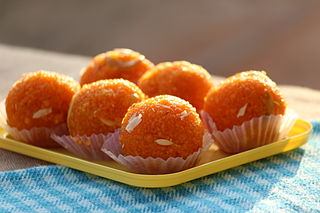
Laddu or laddoo is a spherical sweet from the Indian subcontinent made of various ingredients and sugar syrup or jaggery. It has been described as "perhaps the most universal and ancient of Indian sweets."

Puran poli is an Indian sweet flatbread that is popular in South India and the state of Maharashtra. It is also known as Puran puri, Holige, Obbattu, Bobbattlu, Poley, Bakshamulu, and Boli.

Levantine cuisine is the traditional cuisine of the Levant, in the sense of the rough area of former Ottoman Syria. The cuisine has similarities with Egyptian cuisine, North African cuisine and Ottoman cuisine. It is particularly known for its meze spreads of hot and cold dishes, most notably among them ful medames, hummus, tabbouleh and baba ghanoush, accompanied by bread.
Canarian cuisine refers to the typical dishes and ingredients in the cuisine of the Canary Islands, and it constitutes an important element in the culture of its inhabitants. Its main features are the freshness, variety, simplicity, and richness of its ingredients, the mix of seafood and meat dishes, its cultural influences and the low knowledge of it by the rest of the world. Canarian cuisine is influenced by other cultures, especially that of the aboriginal inhabitants of the islands (Guanches), and has influenced Latin American cuisine.

Kadhi or karhi is a yogurt-based dish originating from Rajasthan, india. It's made by simmering yogurt with besan and indian spices until it forms a thick, tangy gravy. Sometimes, it's also mixed with pakoras. It is often eaten with cooked rice or roti.

Shiro, also called shiro wat, or tsebhi shiro, is a stew served for either lunch or dinner, originating from Ethiopia and Eritrea. An essential part of Eritrean and Ethiopian cuisine, its primary ingredient is powdered chickpeas or broad bean meal and often prepared with the addition of minced onions, garlic and, depending upon regional variation, ground ginger or chopped tomatoes and chili-peppers. Shiro is served atop injera or kitcha. Tegabino shiro is a type of shiro made from heavily spiced legume, chickpea, field pea, or fava bean, oil, and water. It is brought bubbling to the table in a miniature clay pot or shallow aluminum pan. It is often consumed with dark or sergegna injera.
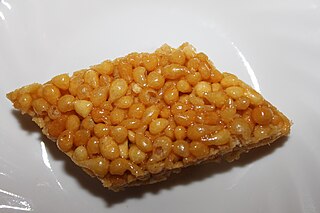
Boondi is an Indian snack made from fried chickpea flour. It is either eaten as a savory snack or sweetened as a dessert.

Panelle are Sicilian fritters made of chickpea flour and other ingredients, usually including water, salt, pepper, olive oil, and finely chopped parsley. They are a popular street food in the city of Palermo and are often eaten between slices of bread or on a sesame roll, like a sandwich. These sandwiches, called pane e panelle, are usually served with a slice of lemon to be squeezed over the panelle.

The cuisine of Bahrain consists of dishes such as biryani, harees, khabeesa, machboos, mahyawa, quzi and zalabia. Arabic coffee (qahwah) is the national beverage.

Ghugni or ghuguni or guguni is a dish made of peas or chickpeas. Different variations of the dish use different types of peas or chickpeas, such as black gram, green peas, or white peas. It is a snack native to the Indian subcontinent, especially popular in Eastern India, Northeast India and in Bangladesh.
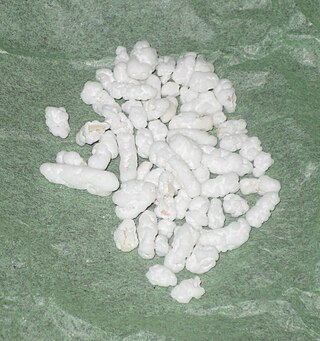
Noghl or Nuql, also Mlabbas, are sugar-coated almonds, a traditional Syrian, Iranian and Afghan confection. It is made by boiling sugar with water and rose water and then coating roasted almonds in the mixture. It can also be made with other nuts such as walnuts or other items. Noghl is often eaten along with tea.

Guasanas is a dish from Mexico consisting of green chickpeas, water and salt. The chickpeas are steamed and shelled before serving.
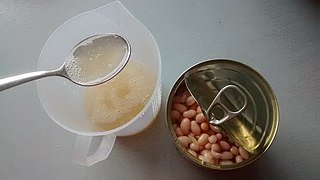
Aquafaba is the viscous water in which legume seeds such as chickpeas have been cooked. Its use in cuisine was the discovery of the French musician Joël Roessel.
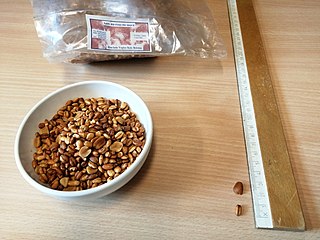
Dabo kolo is an Ethiopian and Eritrean snack and finger food consisting of small pieces of spiced fried dough. Dabo kolo means corn bread in the Amharic language, with dabo for bread, and kolo for corn or roasted barley, chickpeas, sunflower seeds, other local grains and peanuts.

Burmese fritters are traditional fritters consisting of vegetables or seafood that have been battered and deep-fried. Assorted fritters are called a-kyaw-sone. Burmese fritters are generally savory, and often use beans and pulses, similar to South Asian vada.

Nan-e nokhodchi, also called Shirini-e nokhodchi, are cookies made from chickpeas originating in Qazvin, Iran. These are traditionally made from chick-pea flour and flavored with cardamom and garnished with pistachio. They come in varying shapes.

















